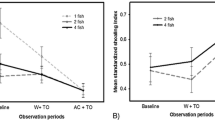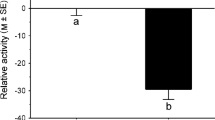Abstract
Fishes in the superorder ostariophysi possess specialized epidermal cells that contain an alarm cue. Fish associate novel odours, such as the odour of a predator, with predation risk after a single, simultaneous exposure to the novel odour and alarm cue. Thereafter, the novel cue is recognized as an indicator of risk and its presence induces antipredator behaviour. Two common antipredator behaviours are reduction in activity and movement to the bottom. This phenomenon has been demonstrated many times in the laboratory setting for a variety of aquatic taxa. In nature however, the detection of novel predator odour may be time-shifted with respect to the detection of alarm cues. Is there a critical period immediately upon the detection of alarm cue in which associative learning can occur? We presented zebra danios, Danio rerio, with the odour of northern pike, Esox lucius, 5 min after presenting them with either alarm cue or water (control). During a predation event, 5 min is a long time. When later retested with pike odour alone, zebra fish conditioned with alarm cue significantly increased antipredator behaviour in terms of decreased activity and movement towards the bottom. Control fish did not recognize pike odour as dangerous when retested. These data show that learned recognition of predation risk is sufficiently robust to accommodate ecologically realistic temporal shifts in stimulus presentation.
Similar content being viewed by others
References
Brown, G.E., D.P. Chivers & R.J.F. Smith. 1995. Fathead minnows avoid conspecific and heterospecific alarm pheromone in the faeces of northern pike. J. Fish Biol. 47: 387–393.
Brown, G.E., D.P. Chivers & R.J.F. Smith. 1997. Differential learning rates of chemical versus visual cues of a northern pike by fathead minnows in a natural habitat. Env. Biol. Fish. 49: 89–96.
Brown, G.E. & J.-G.J. Godin. 1999. Who dares, learns: chemical inspection behaviour and acquired predation recognition in a characin fish. Anim. Behav. 57: 475–481.
Brown, G.E. & R.J.F. Smith. 1996. Foraging trade-offs in fathead minnows (Pimephales promelas): acquired predator recognition in the absence of an alarm response. Ethology 102: 776–785.
Brown, G.E., J.C. Jr. Adrian, E. Smyth, H. Leet & S. Brennan. 2000. Ostariophysan alarm pheromones: laboratory and field tests of the functional significance of nitrogen oxides. J. Chem. Ecol. 26: 139–154.
Chivers, D.P., G.E. Brown & R.J.F. Smith. 1995. Acquired recognition of chemical stimuli from pike, Esox lucius, by brook stickleback, Culaea inconstans (Osteichthyes, Gasterosteidae). Ethology 99: 234–242.
Chivers, D.P & R.J.F. Smith. 1994a. Fathead minnows (Pimephales promelas) acquire recognition when alarm substance is associated with the sight of unfamiliar fish. Anim. Behav. 48: 597–605.
Chivers, D.P. & R.J.F. Smith. 1994b. The role of experience and chemical alarm signaling in predator recognition by fathead minnows, Pimephales promelas Rafinesque. J. Fish Biol. 44: 273–285.
Chivers, D.P. & R.J.F. Smith. 1998. Chemical alarm signalling in aquatic predator/prey systems: a review and prospectus. Écoscience 5: 338–352.
Chivers, D.P., B.D. Wisenden & R.J.F. Smith. 1996. Damselfly larvae learn to recognize predators from chemical cues in the predator's diet. Anim. Behav. 52: 315–320.
Dodson, S.I., T.A. Crowl, B.L. Peckarsky, A.P. Covich & J.M. Culp. 1994. Non-visual communication in freshwater benthos: an overview. J. North Amer. Benthol. Soc. 13: 268–282.
Frisch, K. von. 1938. Zur Psychologie des Fische-Schwarmes. Naturwissenschaften 26: 601–606.
Frisch, K. von. 1941. Über einen Schreckstoff der Fischhaut und seine biologische Bedeutung. Z. vergl. Physiol. 29: 46–145.
Gandolfi, G., L.J. Classon & A.C. Rossi. 1968. The fright reaction of zebra fish. Atti Soc. Ital. Sci. Nat. 107: 74–88.
García, C., E. Rolan-Alvarez & L. Sanchez. 1992. Alarm reaction and alert state in Gambusia affinis (Pisces, Poeciliidae) in response to chemical stimuli from injured conspecifics. J. Ethol. 10: 41–46.
Göz, H. 1941. Über den Art-und Individualgeruch bei Fischen. Z. vergl. Physiol. 29: 1–45.
Hall, D. & M.D. Suboski. 1995. Visual and olfactory stimuli in learned release of alarm reactions by zebra danio fish (Brachydanio rerio). Neurobiol. Learn. Mem. 63: 229–240.
Hartman, E.J. & M.V. Abrahams. 2000. Sensory compensation and the detection of predators: the interaction between chemical and visual information. Proc. Roy. Soc. Lond. B 267: 571–575.
Hews, D.K. 1988. Alarm response in larval western toads, Bufo boreas: release of larval chemicals by a natural predator and its effect on predator capture efficiency. Anim. Behav. 36: 125–133.
Kats, L.B. & L.M. Dill. 1998. The scent of death: chemosensory assessment of predation risk by prey animals. Écoscience 5: 361–394.
Lawrence, B.J. & R.J.F. Smith. 1989. Behavioral response of solitary fathead minnows, Pimephales promelas, to alarm substance. J. Chem. Ecol. 15: 209–219.
Lima, S.L. & L.M. Dill. 1990. Behavioural decisions made under the risk of predation: a review and prospectus. Can. J. Zool. 68: 610–640.
Magurran, A.E. 1989. Acquired recognition of predator odour in the European minnow (Phoxinus phoxinus). Ethology 82: 216–223.
Mathis, A., D.P. Chivers & R.J.F. Smith. 1993. Population differences in responses of fathead minnows (Pimephales promelas) to visual and chemical stimuli from predators. Ethology 93: 31–40.
Mathis, A.,D.P. Chivers & R.J.F. Smith. 1996. Cultural transmission of predator recognition in fishes: intraspecific and interspecific learning. Anim. Behav. 51: 185–201.
Mathis, A. & W.W. Hoback. 1997. The influence of chemical stimuli from predators on precopulatory pairing by the amphipod, G. pulex pseudolimnaeus. Ethology 103: 33–40.
Mathis, A. & R.J.F. Smith. 1993a. Chemical alarm signals increase the survival time of fathead minnows (Pimephales promelas) during encounters with northern pike (Esox lucius). Behav. Ecol. 4: 260–265.
Mathis, A. & R.J.F. Smith. 1993b. Fathead minnows, Pimephales promelas, learn to recognize northern pike, Esox lucius, as predators on the basis of chemical stimuli from minnows in the pike's diet. Anim. Behav. 46: 645–656.
Mathis, A. & R.J.F. Smith. 1993c. Chemical labeling of northern pike (Esox lucius) by the alarm pheromone of fathead minnows (Pimephales promelas). J. Chem. Ecol. 19: 1967–1979.
Nelson, J.S. 1994. Fishes of the world, 4th ed. Wiley-Interscience, New York. 600 pp.
Pfeiffer, W. 1977. The distribution of fright reaction and alarm substance cells in fishes. Copeia 1977: 653–665.
Pfeiffer, W., G. Riegelbauer, G. Meier & B. Scheibler. 1985. Effect of hypoxanthine-3(N)-oxide and hypoxanthine-1(N)-oxide on central nervous excitation of the black tetra Gymnocorymbus ternetzi (Characidae, Ostariophysi, Pisces) indicated by dorsal light response. J. Chem. Ecol. 11: 507–523.
Siegel, S. & N.J. Jr. Castellan. 1988. Nonparametric statistics for the behavioral sciences, 2nd ed. McGraw-Hill, New York. 399 pp.
Smith, R.J.F. 1992. Alarm signals in fishes. Rev. Fish Biol. Fish 2: 33–63.
Suboski, M.D. 1990. Releaser-induced recognition learning. Psychol. Rev. 97: 271–284.
Suboski, M.D., S. Bain, A.E. Carty, L.M. McQuoid, M.I. Seelen & H. Seifert. 1990. Alarm reaction in acquisition and social transmission of simulated-predator recognition by zebra danio fish (Brachydanio rerio). J Comp. Psychol. 104: 101–112.
Waldman, B. 1982. Quantitative and developmental analysis of the alarm reaction in the zebra danio, Brachydanio rerio. Copeia 1982: 1–9.
Wisenden, B.D. 2000. Scents of danger: the evolution of olfactory ornamentation in chemically-mediated predator-prey interactions. pp. 365–386. In: Y. Espmark, T. Amundsen & G. Rosenqvist (ed.) Animal Signals: Signalling and Signal Design in Animal Communication, Tapir Academic Press, Trondheim.
Wisenden, B.D., D.P. Chivers, G.E. Brown & R.J.F. Smith. 1995. The role of experience in risk assessment: avoidance of areas chemically labeled with fathead minnow alarm pheromone by conspecifics and heterospecifics. Écoscience 2: 116–122.
Wisenden, B.D., D.P. Chivers & R.J.F. Smith. 1997. Learned recognition of predation risk by Enallagma damselfly larvae (Odonata, Zygoptera) on the basis of chemical cues. J. Chem. Ecol. 23: 137–151.
Wisenden, B.D., A. Cline & T.C. Sparkes. 1999. Survival benefit to antipredator behavior in Gammarus minus (Crustacea: Amphipoda) in response to injury-released chemical cues from conspecifics and heterospecifics. Ethology 105: 407–414.
Wisenden, B.D. & K.R. Harter. 2001. Motion, not shape, facilitates association of predation risk with novel objects by fathead minnows (Pimephales promelas). Ethology 107 (in press).
Wisenden, B.D. & R.J.F. Smith. 1997. The effect of physical condition and shoalmate familiarity on proliferation of alarm substance cells in the epidermis of fathead minnows. J. Fish Biol. 50: 799–808.
Wisenden, B.D. & R.J.F. Smith. 1998. A re-evaluation of the effect of shoalmate familiarity on the proliferation of alarm substance cells in ostariophysan fishes. J. Fish Biol. 53: 841–846.
Woody, D.R. & A. Mathis. 1998. Acquired recognition of chemical stimuli from an unfamiliar predator: associative learning by adult newts, Notophthalmus viridescens. Copeia 1998: 1027–1031.
Yunker, W.K., D.E. Wein & B.D. Wisenden. 1999. Conditioned alarm behavior in fathead minnows (Pimephales promelas) resulting from association of chemical alarm pheromone with a non-biological visual stimulus. J. Chem. Ecol. 25: 2677–2686.
Author information
Authors and Affiliations
Corresponding author
Rights and permissions
About this article
Cite this article
Korpi, N.L., Wisenden, B.D. Learned Recognition of Novel Predator Odour by Zebra Danios, Danio Rerio, Following Time-shifted Presentation of Alarm Cue And Predator Odour. Environmental Biology of Fishes 61, 205–211 (2001). https://doi.org/10.1023/A:1011091426030
Issue Date:
DOI: https://doi.org/10.1023/A:1011091426030




